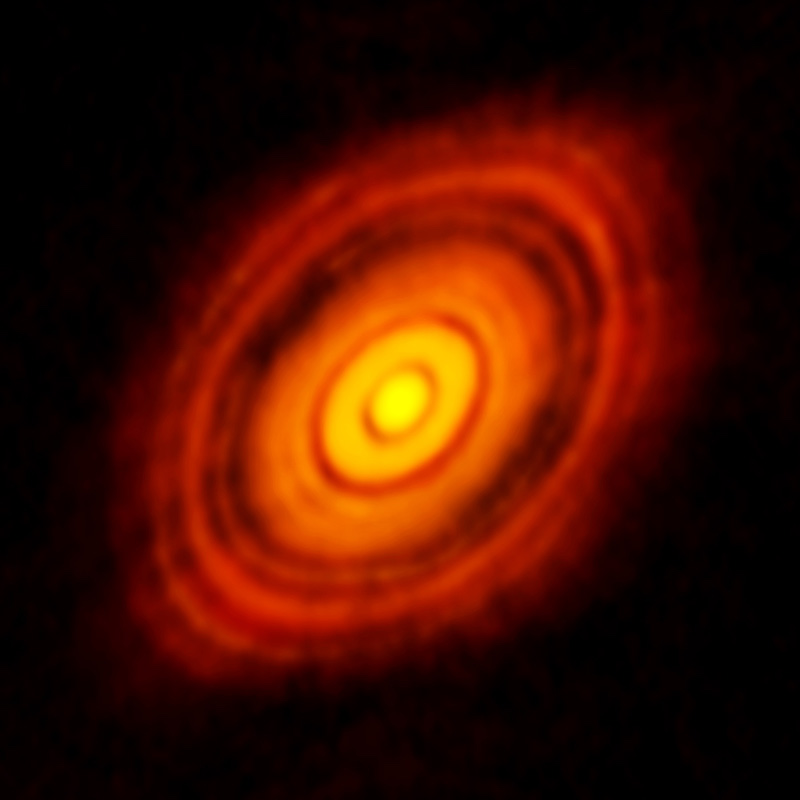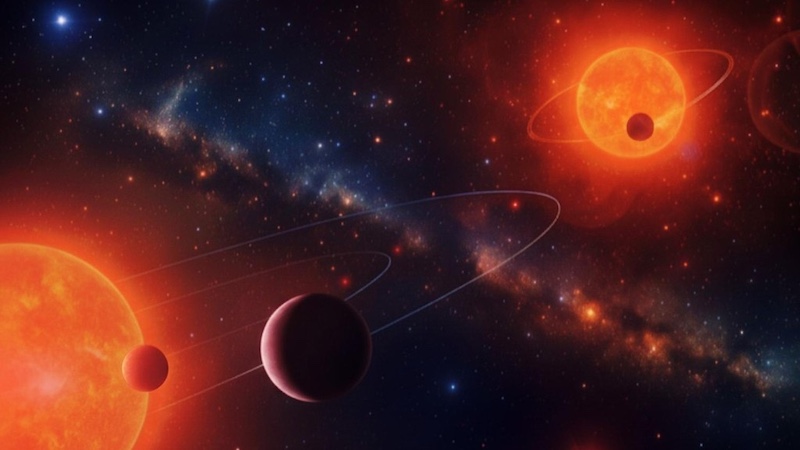Now Reading: Young Jupiter protected Earth from the sun, study finds
-
01
Young Jupiter protected Earth from the sun, study finds
Young Jupiter protected Earth from the sun, study finds


Science matters. Wonder matters. You matter.
Join our 2025 Donation Campaign today.
Young Jupiter protected Earth from the sun
New research claims Jupiter served as the early solar system’s architect, creating the conditions that allowed Earth as we know it to exist. And the gas giant’s influence might also explain a long-standing mystery surrounding the formation of meteorites.
On October 22, 2025, scientists from Rice University said they had performed cutting-edge simulations of the solar system’s early years. These simulations revealed how the rapid growth of a young Jupiter disrupted the disk of gas and dust surrounding our star, shepherding planet-forming material into dense bands.
These bands, the researchers said, help explain how an important group of meteorites could have formed so long after the solar system’s birth. And they could be the reason that a young Earth didn’t spiral inward toward the sun.
Study co-author André Izidoro of Rice University said:
Jupiter didn’t just become the biggest planet – it set the architecture for the whole inner solar system. Without it, we might not have Earth as we know it.
The researchers published their peer-reviewed study on October 22, 2025, in the journal Science Advances.
Jupiter made waves in the early solar system
Jupiter is a titan of a planet, with over twice as much mass as the rest of the solar system’s planets combined. And when it started rapidly accumulating mass as a young world, it had a dramatic impact on the solar system’s development.
The new study said Jupiter’s quickly growing gravitational pull sent mighty ripples through the disk of gas and dust around our young star. And these ripples created what the researchers have described as cosmic traffic jams, condensing the dust particles into dense bands.
This finding is consistent with what we see when we look out into the Milky Way galaxy. The Atacama Large Millimeter/submillimeter Array telescope (ALMA) has spotted bands just like these in the dust around young stars. Izidoro noted:
Looking at those young disks, we see the beginning of giant planets forming and reshaping their birth environment. Our own solar system was no different.

A split in the disk
One particularly prominent gap in the disk formed around Jupiter’s orbit. And this barrier essentially split the inner solar system from the outer solar system.
We see evidence of this in meteorites. Scientists have found that meteorites can be divided very neatly into two categories: carbonaceous (typically rich in ice) and non-carbonaceous (typically dry and metallic). Why don’t we find meteorites containing a mix of carbonaceous material and non-carbonaceous material?
The answer lies in the fact that carbonaceous material originated in the outer solar system, and non-carbonaceous material originated in the inner solar system. By splitting the solar system in two, Jupiter acted as a barrier that stopped these substances from mixing.
And that has left us with two distinct kinds of meteorite. As Izidoro said:
Jupiter’s early growth left a signature we can still read today, locked inside meteorites that fall to Earth.
A meteorite mystery
But here’s the mystery. Over time, much of the dust in the inner solar system should have dissipated, either by clumping into larger objects or by falling into the sun. And this dust wasn’t being replaced, since Jupiter was preventing particles from migrating in from the outer solar system. So the inner solar system should have quickly run out of material.
But it didn’t. We know it didn’t, because a group of meteorites from the chondrite family formed in this region several million years after the first solids in our solar system came together.
For decades, scientists have wondered how there was enough material still around for these chondrites to form so late. Izidoro explained:
The mystery has always been: Why did some of these meteorites form so late, two to three million years after the first solids? Our results show that Jupiter itself created the conditions for their delayed birth.
The new study reveals that the ripples emanating from Jupiter also created a barrier, or a pressure bump, around the sun. And that barrier prevented particles from falling inward to a fiery demise.
In other words, Jupiter made the inner solar system a storage zone where material could collide, clump together, break apart and clump together again, all without being lost to the sun. And it was from this reservoir that a few chunks of material grew into Earth, Mars, Venus and Mercury.

Jupiter protected Earth from the beginning
And Jupiter’s influence on our planet doesn’t end there. The new simulations also revealed that the planet protected Earth as it grew, keeping it at a safe distance from the sun.
This answers another longstanding mystery. In our galaxy, astronomers have found a huge population of exoplanets orbiting exceedingly close to their stars: closer even than Mercury, our solar system’s innermost planet. So it seems that something – likely a phenomenon known as gas drag – tends to pull planets inward into very tight orbits. But why did this not happen in our solar system? And why, in particular, are Earth, Mars and Venus all clustered around one astronomical unit (one Earth-sun distance) from our star?
Again, Jupiter might be the key. The researchers say that by cutting off the flow of gas into the inner solar system, Jupiter suppressed the inward migration of young planets. So rather than falling inward toward the sun, they were held in a comfortable, material-rich zone to evolve into the worlds we know today.
So, according to the new research, Jupiter didn’t only help provide Earth with the material it needed to grow. It also placed our world in a safe, temperate region where liquid water could one day help life to spark and flourish.
Bottom line: New simulations reveal how Jupiter protected Earth from the sun in our planet’s early years, while also explaining a long-standing meteorite mystery.
Source: The late formation of chondrites as a consequence of Jupiter-induced gaps and rings
The post Young Jupiter protected Earth from the sun, study finds first appeared on EarthSky.
Stay Informed With the Latest & Most Important News
-
 012024 in Review: Highlights from NASA in Silicon Valley
012024 in Review: Highlights from NASA in Silicon Valley -
 02Panasonic Leica Summilux DG 15mm f/1.7 ASPH review
02Panasonic Leica Summilux DG 15mm f/1.7 ASPH review -
 03From Polymerization-Enabled Folding and Assembly to Chemical Evolution: Key Processes for Emergence of Functional Polymers in the Origin of Life
03From Polymerization-Enabled Folding and Assembly to Chemical Evolution: Key Processes for Emergence of Functional Polymers in the Origin of Life -
 04How New NASA, India Earth Satellite NISAR Will See Earth
04How New NASA, India Earth Satellite NISAR Will See Earth -
 05And Thus Begins A New Year For Life On Earth
05And Thus Begins A New Year For Life On Earth -
 06Astronomy Activation Ambassadors: A New Era
06Astronomy Activation Ambassadors: A New Era -
07SpaceX launch surge helps set new global launch record in 2024




















